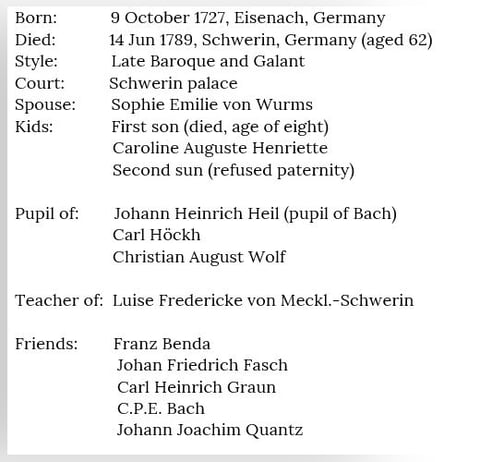Johann Wilhelm Hertel
Early life in Eisenach
Zerbst and Neustrelitz, 1742 - 1752
Berlin, 1747
Schwerin, 1754 - 1759
Stralsund, 1759 - 1761
Schwerin Court Chapel, 1761 - 1789
Personal life
Death
Compositions
Autobiography notes
References


Born: 9 October 1727, Eisenach, Germany
ied: 14 Jun 1789, Schwerin, Germany (aged 62)
Style: Late Baroque and Galant
Court: Schwerin palace
Spouse: Sophie Emilie von Wurms
Kids: First son (died, age of eight)
Caroline Auguste Henriette
Second sun (refused paternity)
Pupil of: Johann Heinrich Heil (pupil of Bach)
Carl Höckh
Christian August Wolf
Teacher of: Luise Fredericke von Meckl.-Schwerin
Friends: Franz Benda
Johan Friedrich Fasch
Carl Heinrich Graun
C.P.E. Bach
Johann Joachim Quantz
Würzburg Prince-archbishop residence


Great support for the musical life of Würzburg was provided by three prince-bishops: Johann Philipp Franz von Schönborn (1719-24), Friedrich Carl von Schönborn (1729-46), and Adam Friedrich von Seinsheim (1755-79).
Giovanni Benedetto Platti (1697 - 1763), was the only Italian musician to remain in Würzburg until the rest of his life. His career was closely tied to the family of the counts von Schönborn, the patrons and connoisseurs of arts.
Fortunato Chelleri (c. 1690 – 1757), was a typical example of the many eighteen-century Italian composers who travelled across Europe in search of work and recognition. Chelleri’s period in Würzburg, was perhaps the most productive and untroubled of his career.
